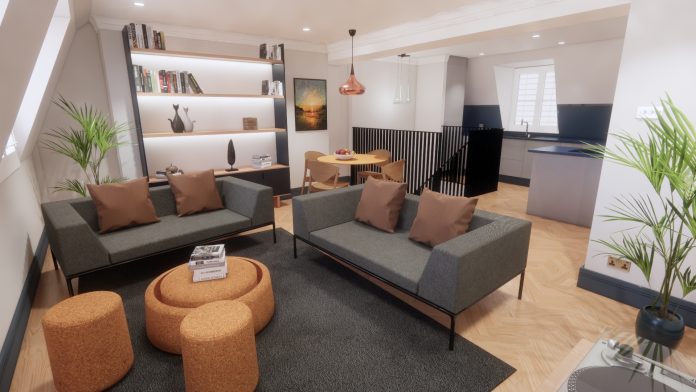Architect maber has renovated 31a James Street in Covent Garden to create three bright and contemporary apartments in the heart of central London with Archicad and Enscape
Previously storerooms and offices for the shops located below, the upper floors of the building have been transformed to create spacious and stylish living spaces in the form of one- and two-bedroom contemporary apartments.
A new interior layout
With a brief to retain the ground floor retail space, convert the upper floors of the building into three high-specification contemporary apartments and use the cellar for plant and equipment, a full architectural package was required.
After carrying out the initial survey, maber’s architectural team worked with structural engineers to remodel the building by completely redesigning the interior layout. As part of this overhaul, the new design made use of the roof area to create more usable space for the contemporary apartments.
Bringing the interior designs of the contemporary apartments to life using Archicad and Enscape
maber’s interior design team used a combination of Archicad and Enscape to model and showcase the detail of the interiors.
Jonathan Martin, interior designer and CAD visualiser at maber, explains: “There is a direct two-way exchange between Archicad and Enscape. We used the materials library within Archicad, which is then duplicated in Enscape. If we change the colour of a material in Enscape, it automatically changes in Archicad and vice versa. This worked really well for us, as it is so much easier working with just one central model.
“In addition, we used Enscape to create real-time flythroughs with a finished render. The client really enjoyed that option and loved the detail that we had included.”
Chris Radcliffe, head of interiors at maber, continues: “Archicad and Enscape helped us to visualise the materiality of the apartments and enabled us to represent soft furnishing textures and colour, reflectiveness, metal, glass, tiles and timber grain. In addition, the accurate renditions of both natural light using Archicad’s sun path analysis tool and artificial lighting effects really brought the scheme to virtual life when presented as an experiential walk-through.
“We clipped static images from the model to share with the teams, which assisted the storytelling and informed subcontractors of the design intent. Junctions and clashes of materials could be interrogated from different angles to ensure fit-and-finish was correct prior to building, and we could stand in spaces virtually to see if furniture, fittings and equipment worked as planned.”
Design details for a high-end finish
The details of the design were essential to create the right look and feel for the contemporary apartments. For example, maber insisted on a flat steel bar for the new top-floor accommodation staircase bannister, which provides a contemporary counterpoint to the traditional oak treads of the stairs. Instead of carpeting main circulation staircases throughout, the team chose a high- specification carpet runner with matte black stair rods.
The team opted for bronze and brass ironmongery, which was chosen for its aged quality – respecting the history of the building while also giving it a contemporary aesthetic. Meanwhile, the oak parquet flooring specified by maber lifted the apartments into a different rental category.
The Archicad Morph tool was used for modelling the skirting, which has an unusual double groove, while cornices were reinstated to respect the building’s period details.
Coordinating complex M&E
The M&E data was imported and exported into Archicad via IFC files and maber used the renovation filter within Archicad to clearly demonstrate which elements of the existing
building would be removed and which were staying.
“Archicad proved invaluable for showing where the M&E should run. Mechanical and electrical requirements needed to be shoehorned into a complex labyrinth of ducts, risers and ceiling voids,” says Radcliffe.
“In some instances, proposed ceiling heights were visualised in 3D so that ducting, access hatches and grille positions could be accurately located; this method of a more iterative yet collaborative approach resulted in time saved and fully coordinated M&E solutions.
“It was very useful to easily be able to see where the existing downpipes and drainpipes were – what was being ripped out and replaced, and what was staying. In the kitchens, we wanted to show where all the cabling was going and being able to demonstrate this in 3D and colour was invaluable.”
Clear documentation and communication deliver a high-specification result
maber put together a package of information including plans, sections, elevations and
specifications for the fit-out contractor with all the information directly exported from Archicad.
“The contractor was very impressed with the standard of information we produced. Using Archicad helps us to be very thorough and methodical,” says Radcliffe.
“The Archicad model is a great communication tool for the whole team and aided the architect, main contractor, structural engineer, M&E contractor and subcontractors during construction and fit-out.”
Graphisoft UK
Tel: +44 (0)1895 527590
*Please note: This is a commercial profile

















